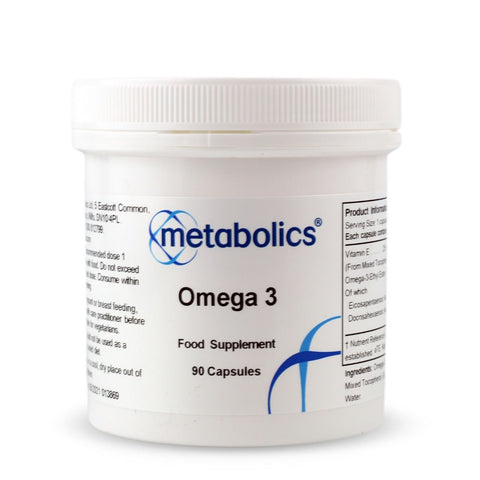Suitable For
Metabolics Omega 3 oils are sourced from the flesh of the fish and not the livers. It is extracted from anchovy, sardine and mackerel caught off the coast of South America. It is a by-product of the Peruvian fishing industry, therefore making use of a product considered a waste product of another industry.
Harvesting of fish for the General Law of Fishery regulates the fish oil industry and Marine Institute of Peru which constantly monitors Peruvian waters to ensure the presence of a constant biomass, thereby avoiding deprivation. The anchovy, Peru’s main fish species in the production of fish oil has maintained its population for the past 50 years due to a responsible catch policy. Every batch of oil is accompanied by a certificate of analysis which demonstrates that toxicity level of stated toxins such as pesticides and heavy metals is either non-existent or well below the permissible levels.
Omega fats can oxidise and go rancid in the capsule leading to free radicals in the body. Taking rancid oil is dangerous because oxidized fats actually raise your risk of heart disease and blood clots, according to Rufus Turner, leading expert on oils at the University of Reading in the U.K. This product contains antioxidants in the form of mixed tocopherols to the capsules. These are naturally sourced and non GMO with a typical profile of, alpha tocopherol:13%, beta tocopherol 2%, gamma tocopheol 58%, delta tocopherol 27%. These are derived from vegetable oils by physical, not chemical extraction so leaving no chemical residues. Every batch of fish oil used in Metabolics Omega 3 has accompanying certification confirming any oxidation of the oil is either non existent or within the lower level of acceptable oxidation levels.
Studies have shown that eating fish and certain fish oils can potentially expose you to a high degree of contamination with industrial pollutants and toxins like mercury, PCBs, heavy metals and radioactive poisons. Every batch of oil used in Metabolics Omega 3 capsules is accompanied by a certificate of analysis which demonstrates that toxicity level of stated toxins such as pesticides and heavy metals is either non-existent or well below the permissible levels
Most companies that provide Omega 3 oils, provide them in capsules made from bovine gelatine. Metabolics uses a premium high quality fish gelatine, providing uniformity of product throughout.
Why Choose Metabolics Omega 3 oils?
Omega 3 oils are one of a group of fats, which together with Omega 6 fats are Essential Fatty Acids (EFA). This means that they are essential for human health but cannot be made by the body. They have to be obtained from the diet.
Omega 3 fatty acids are a group of 3 fats called ALA (Alpha Linoleic Acid - found in plant oils) EPA (Eicosapentaenoic acid) and DHA (Docosahexanoic acid) found in oily fish such as mackerel, herrings, sardines and salmon as well as algae and krill. The body is able to convert ALA to EPA and DHA, although it is not very efficient, making oily fish an important part of the diet.
Omega 6 oils are found in plant oils and some animal fats.
A ratio of 1:1 of Omega 3:6 oils is considered optimal. As Omega 6 is quite abundant in the Western diet, any deficiency is more commonly of Omega 3.
Omega 3 (EPA and DHA) are needed for:
Heart health
http://www.ncbi.nlm.nih.gov/pubmed/17047219
EPA and DHA (250mg daily intake) have been shown to reduce the risk of coronary death by 36% and total mortality by 17%. It has also been shown to prevent and treat atherosclerosis (hardening of the arteries) by slowing down the development of plaque and blood clots, which may clog up arteries. The beneficial effect for maintaining normal cardiac function is obtained from a daily intake if 250mg EPA and DHA.
Maintaining normal blood fat levels.
EPA ,DHA and ALA contribute to normal blood cholesterol levels. This beneficial effect is obtained with a daily intake of 2gm DHA and a daily intake of 5gm combined EPA and DHA should not be exceeded.
Maintaining normal blood pressure.
This beneficial effect is obtained with intake of 3gm EPA and DHA, although a supplemental intake of 5gm DHA and EPA combined should not be exceeded
For normal brain and eye development in the foetus and breastfed babies.
Pregnant and lactating women can obtain a beneficial effect when doses of 200mg DHA are taken in addition to the recommended daily intake of Omega 3 fatty acids ( i.e 250mg DHA and EPA) Ref: Omega 3 DHA and EPA for cognition, behavior, and mood: clinical findings and structural-functional synergies with cell membrane phospholipids. By PM Kidd Published in Alternative Medicine review 2007 Sep;12 (3) : 207-27
Fatty acids play a role in every single cell wall.
Every cell wall is composed of phospholipids, which are arranged in two layers. A phospholipid is a fat joined onto a phosphate molecule. The phosphate head of each layer faces outwards and attract water and the fat, hydrophobic or water hating tails face inwards.
Cell membranes are permanently under repair. EPA and DHA function via cell membranes in which they are anchored by phospholipid molecules.
Supplement Facts
Each capsule contains
%NRV*
Vitamin E
25 mg α TE (50 IU)
208%
(From Mixed Tocopherols 50 mg)
Omega-3-Ethyl Ester
1000 mg
†
Of which
Eicosapentaenoic Acid
330 mg
Docosahexaenoic Acid
220 mg
† Nutrient Reference Value (NRV*) not established
α TE: Alpha Tocopherol
Ingredients
Directions / Dosage
 Capsules
Capsules
Warning
Storage
Product Type





